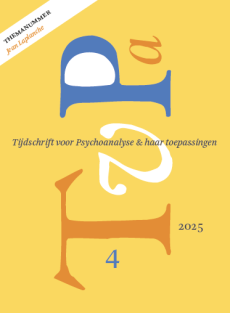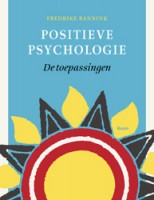De psychoanalytische identiteit
Summary
Psychoanalytic identity psychoanalysis as an internal object
This paper presents a specific description of the psychoanalytic identity, whose nucleus is assumed to comprise the psychic representation of psychoanalysis in the internal world of the analyst i.e. psychoanalysis as an internal object. Three aspects of it are described: 1) the inquiring attitude; 2) trust in the unconscious communicative process; and 3) trust in the psychoanalytic setting. Unstable analytic objects, such as the strong ambivalent object, the split object and the narcissistic object, may come into being owing to factors within the analyst. The causes and forms of all three are discussed. Training is crucial to the development of a psychoanalytic identity. As a result of ambivalence, analytic training standards are liable to be relaxed and the analytic identity to be diluted. This process is reinforced by the worldwide trend for analysts to analyse fewer and fewer cases. The crisis in psychoanalysis is first and foremost a crisis within the analyst, and in particular, in his or her analytic identity.
Key words:
crisis in psychoanalysis, internal (analytic) object, psychoanalytic identity
Literatuur
- Brauer, L. (1993). Basic report about members who are graduates of institutes, survey of psychoanalytic practice. In: Proceedings, Meetings of Members, with Appendices, APA Fall Meeting 1993.
- Busch, F. (2001). Are we losing our mind? Journal of the American Psychoanalytic Association, 49, 739-751.
- Faimberg, H. (1996). Listening to the listening. International Journal of Psychoanalysis, 77, 667-679.
- Freud, S. (1933). Neue Folge der Vorlesungen zur Einführung in die Psychoanalyse. Gesammelte Werke XV. Frankfurt: S. Fischer.
- Fogel, G.I. & Glick, R.A. (1991). The analysts postgraduate development: Rereading Freud and working theory through. Psychoanalytic Quarterly, 60, 396-425.
- Grinberg, L. (1990). The identity of the psychoanalyst. In The goals of psychoanalysis, identification, identity and supervision (p. 117-126). Londen: Karnac Books.
- Joseph, E.D. (1983). Identity of the psychoanalyst. In E.D. Joseph & D. Widlöcher (red.), The identity of the psychoanalyst. New York: International Universities Press.
- Kernberg, O.F. (1987). The basic intra-psychic organisation of the analyst and the features which threaten or favour the maintenance of his psychoanalytic identity and functioning. In J. Chasseguet-Smirgel (red.) (1987). Maintenance of the psychoanalytic identity and functioning in a world of flux. IPA Monograph Series 6 (p. 63-76). Londen: IPA.
- King, P. (1978). Affective response of the analyst to the patients communications. International Journal of Psychoanalysis, 59, 329-334.
- Klauber, J. (1986). Difficulties in the analytic encounter. Londen: Free Association Books.
- McLaughlin, J. (1961). The analyst and the Hippocratic oath. Journal of the American Psychoanalytic Association, 9, 106-123.
- Ogden, T.H. (1992). Misrecognitions and the fear of not knowing. In: Th. Ogden, The primitive edge of experience (p. 195-221). Londen: Karnac.
- Parsons, M. (1995). Does the analyst have a unique identity? EPF Bulletin 44, 73-86.
- Poland, W.S. (2002). The interpretative attitude. Journal of the American Psychoanalytic Association, 50, 807-826.
- Saussure, J. de (1987). How can the training analysis and the organisation of the psychoanalytic societies help to establish and maintain a psychoanalytic identity and functioning? In J. Chasseguet-Smirgel (red.) (1987). Maintenance of the psychoanalytic identity and functioning in a world of flux IPA Monograph Series 6 (p. 127-135). Londen: IPA.
- Schafer, R. (1979). On becoming a psychoanalyst of one persuasion or another. Contemporary Psychoanalysis, 15, 345-360.
- Shengold, L. (1987). Contribution to the discussion. In J. Chasseguet-Smirgel (red.), Maintenance of the psychoanalytic identity and functioning in a world of flux. IPA Monograph Series 6 (p. 137-143). Londen: IPA.
- Roth, P. (2001). Mapping the landscape: levels of transference interpretation. International Journal of Psychoanalysis, 82, 533-543.
- Spitz, R. (1956). Transference: the analytical setting and his prototype. International Journal of Psychoanalysis, 37, 380-385.
- Stone, L. (1961). The psychoanalytic situation. New York: International Universities Press.
- Wallerstein, R.S. (1987). Maintenance of the psychoanalytical identity and functioning in a world of flux: the terms of the dialectic. In J. Chasseguet-Smirgel (red.), Maintenance of the psychoanalytic identity and functioning in a world of flux. IPA Monograph Series 6 (p. 21-61). Londen: IPA.
- Wheelis, A. (1956). The vocational hazards of psycho-analysis. International Journal of Psychoanalysis, 37, 171-184.
- Widlöcher, D. (1983). Psychoanalysis today: a problem of identity. In E.D. Joseph & D. Widlöcher (red.), The identity of the psychoanalyst. New York: International Universities Press.
- Wille, R.S.G. (1992). Liggen of zitten. Rotterdam: Universiteits Drukkerij.
 © 2009-2025 Uitgeverij Boom Amsterdam
© 2009-2025 Uitgeverij Boom Amsterdam
ISSN 1382-516x
De artikelen uit de (online)tijdschriften van Uitgeverij Boom zijn auteursrechtelijk beschermd. U kunt er natuurlijk uit citeren (voorzien van een bronvermelding) maar voor reproductie in welke vorm dan ook moet toestemming aan de uitgever worden gevraagd:
Behoudens de in of krachtens de Auteurswet van 1912 gestelde uitzonderingen mag niets uit deze uitgave worden verveelvoudigd, opgeslagen in een geautomatiseerd gegevensbestand, of openbaar gemaakt, in enige vorm of op enige wijze, hetzij elektronisch, mechanisch door fotokopieën, opnamen of enig andere manier, zonder voorafgaande schriftelijke toestemming van de uitgever.
Voor zover het maken van kopieën uit deze uitgave is toegestaan op grond van artikelen 16h t/m 16m Auteurswet 1912 jo. Besluit van 27 november 2002, Stb 575, dient men de daarvoor wettelijk verschuldigde vergoeding te voldoen aan de Stichting Reprorecht te Hoofddorp (postbus 3060, 2130 KB, www.reprorecht.nl) of contact op te nemen met de uitgever voor het treffen van een rechtstreekse regeling in de zin van art. 16l, vijfde lid, Auteurswet 1912.
Voor het overnemen van gedeelte(n) uit deze uitgave in bloemlezingen, readers en andere compilatiewerken (artikel 16, Auteurswet 1912) kan men zich wenden tot de Stichting PRO (Stichting Publicatie- en Reproductierechten, postbus 3060, 2130 KB Hoofddorp, www.cedar.nl/pro).
No part of this book may be reproduced in any way whatsoever without the written permission of the publisher.
Nieuwsbrief Boom Psychologie
Meld u nu aan en ontvang maandelijks de Boom Psychologie nieuwsbrief met aantrekkelijke aanbiedingen en de nieuwe uitgaven.
Aanmelden


